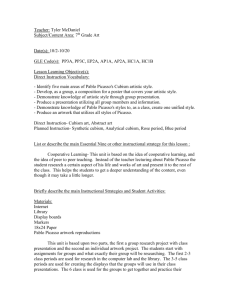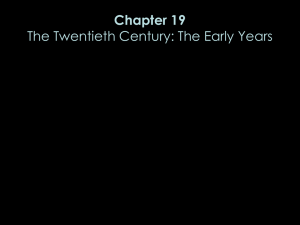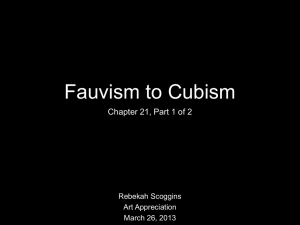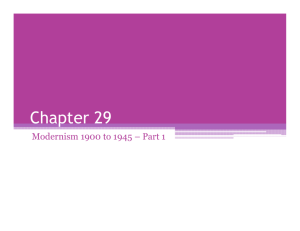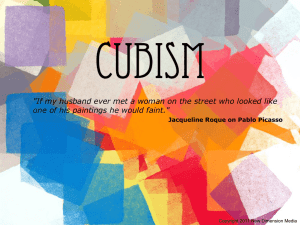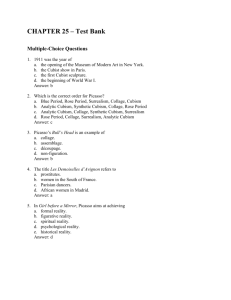14. Cubism
advertisement
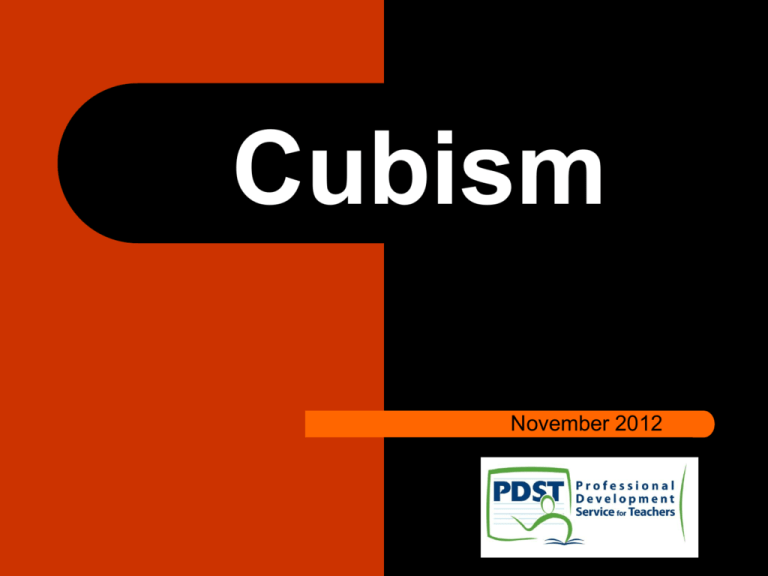
Cubism November 2012 Pablo Picasso and George Braque Pablo Picasso George Braque Inspired by Paul Cezanne, Pablo Picasso and George Braque developed the Cubist style in Paris between 1907 and 1914 together. http://artyfactory.com/art_appreciation/art_movements/cubism.htm PAUL CÉZANNE (1839-1906) 'Bibemus Quarry', 1895 Cézanne abandoned perspective drawing and traditional realism. He saw painting as construction and arrangement of colour on a two-dimensional surface. It was this flat abstract approach that appealed to the Cubists and their early paintings. http://artyfactory.com/art_appreciation/art_movements/cubism.htm PICASSO Factory, Horta de Ebbo 1909 In Cubism, subjects are reduced to basic geometrical shapes. Cezanne's doctrine of "Every thing in nature takes it's form from the sphere, cone or cylinder.“ defined cubism. Pablo Picasso, Woman with a Fan, 1907-1908 Primitive Cubism, 1907/1908 http://www.galilean-library.org/site/index.php/page/index.html/_/essays/art/theroots-of-modern-art-part-7-picasso-i-r15 http://www.arthistoryarchive.com/arthistory/cubism/ http://www.hermitage.nl/en/tentoonstellingen/matisse_tot_malevich/hoogtepunten.htm There are three basic types of cubism Portrait of Ambroise Vollard, Picasso (1910) Analytical Cubism, 1907/1912 Glass and Bottle of Suze Synthetic Cubism. 1913/1920’s Primitive cubism 1907 / 1908 Les Demoiselles d'Avignon of 1907 truly introduced Cubism as a modern art movement. Picasso was greatly interested in primitive statues and sculptures, which he showed in his work immediately preceding the Les Demoiselles. Notice his use of the primitive African masks on the right. http://www.angelfire.com/co/artgeometry/ Analytical Cubism 1908 / 1912 In the analytic phase (1907—12) the cubist palette was severely limited, largely to black, browns, greys, and off-whites. Forms were rigidly geometric and compositions were subtle and intricate. The idea being to break down an image into its many angles and views, as if to "analyse" them in all their possible forms. http://www.dailyartfixx.com/tag/georges-braque/ http://www.artchive.com/artchive/P/picasso_analyticalcubism.html Portrait of Ambroise Vollard (1910) Picasso Girl with a Mandolin (1910) Pablo Picasso Synthetic Cubism 1912 / 1919 Synthetic Cubism developed through a construction process rather than the analytical process such as collage. It was seen as the first time that collage had been made as a fine art work. The first work of this new style was Picasso's Still Life with Chair-caning (1911-1912), which includes oil cloth pasted on the canvas. http://smarthistory.khanacademy.org/cubism.html Pablo Picasso, Still Life with Chair Caning, 1911 Picasso, Bottle and Wine Glass on a Table, 1912 Georges Braque, "Fruit Dish and Glass" 1912 http://johntimmons.com/art103/?tag=orphism http://www.metmuseum.org/toah/works-of-art/49.70.33 Glass, Bottle and Journal 1912 Charcoal and faux-bois wallpaper on paper, 48 x 62 cm Notice how Colour is stuck on, line or shading is drawn in charcoal. The glued-on imitation wood wallpaper is an ‘authentic’ illusion, as it were, hence a witty response to the call for more realism in art. http://www.moma.org/collection/object.php?object_id=78630 In contrast to Analytic Cubism, Synthetic Cubism is arrived at through a construction process rather than an intellectual breaking down of forms found in the real world such as cylinders, spheres, and cones. Synthetic Cubism is more decorative and experimental in nature than Analytic Cubism. http://www.artrevived.com/blogs/art-revivedblog/1132992-the-story-behind-picassosthree-musicians Three Musicians Fontainebleau, summer 1921 PDST Professional Development Service for Teachers Acknowledgements Many thanks to the following for their invaluable contribution to the European Art History and Appreciation series of workshops and resource materials. Art Associates Local Facilitator Team Maria Moore Margaret O’Shea Aine Andrews Joe Caslin Jane Campbell Siobhan Campbell Niamh O’Donoghue Niamh O’Neill Keith O’Rahilly Sheena McKeon Tony Morrissey Monica White PDST Professional Development Service for Teachers Cultural & Environmental Education Professional Development Service for Teachers (PDST) Dublin West Education Centre, Old Blessington Road, Tallaght, Dublin 24 National Co-ordinator Conor Harrison Mobile: 087 240 5710 E-mail: conorharrison@pdst.ie The PDST is funded by the Department of Education and Skills under the National Development Plan 2007 2013 Administrator Angie Grogan Tel: 014528018 Fax: 014528010 E-mail: angiegrogan@pdst.ie.



